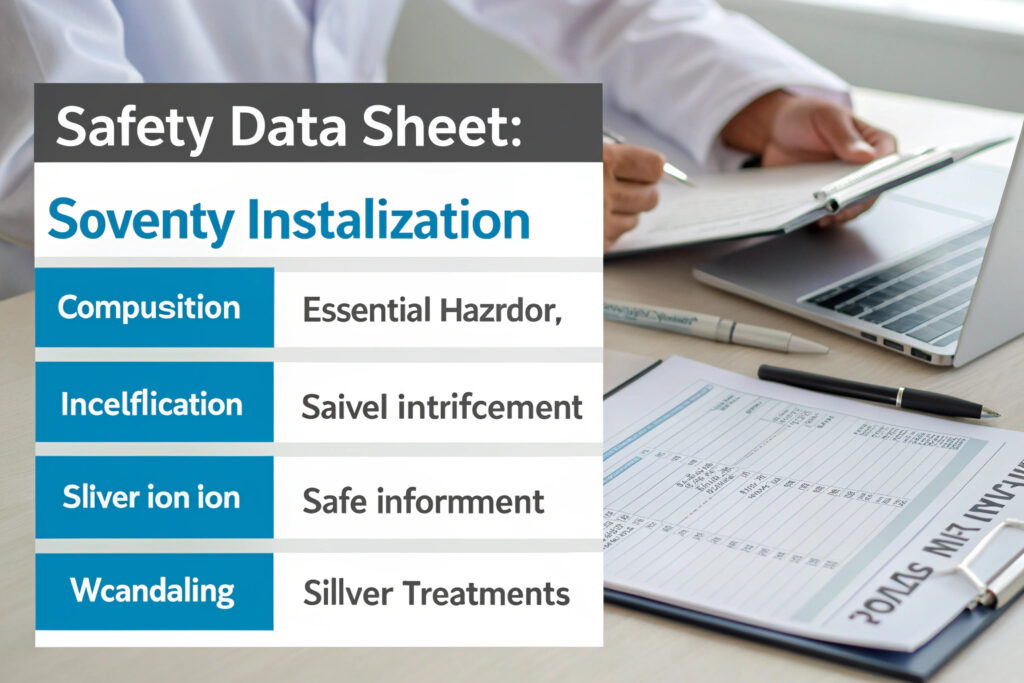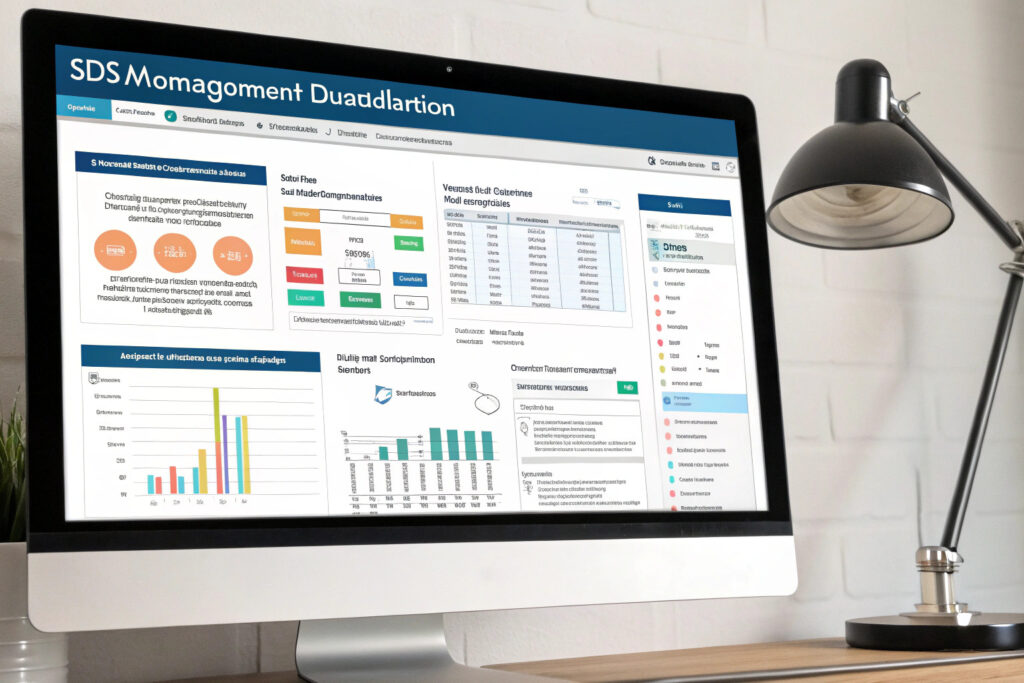Navigating Safety Data Sheet (SDS) requirements for silver ion treatments in fabric masks involves understanding both regulatory obligations and practical compliance steps. Silver ion antimicrobial treatments, while effective, fall under chemical regulation in most markets, requiring specific documentation, hazard communication, and compliance with both textile and chemical safety frameworks. Proper SDS management ensures legal compliance, protects your business from liability, and builds trust with increasingly informed consumers.
To navigate SDS requirements for silver ion treatments, manufacturers must obtain complete SDS from suppliers, verify silver compound classification, ensure proper labeling, maintain usage documentation, and understand jurisdiction-specific regulations that may classify treated masks as biocidal articles. The process requires coordination between your chemical suppliers, manufacturing team, and compliance specialists to address both substance-level and article-level regulatory requirements.
The regulatory landscape for silver ion treatments varies significantly between markets, with the EU's Biocidal Products Regulation (BPR), US EPA regulations, and Asian chemical management laws each having distinct requirements. Successfully navigating these requirements involves both understanding the specific silver compounds used and how they're incorporated into your final products. Let's examine the specific steps and considerations for SDS compliance.
What Specific Information Should SDS Contain for Silver Treatments?
A compliant SDS for silver ion treatments must contain specific information relevant to both workplace safety and end-product compliance.

What composition details are essential?
The SDS must specify the exact silver compound used (e.g., silver chloride, silver zinc zeolite, or silver phosphate), concentration percentages, and any carrier substances. Many regulatory challenges arise from incomplete composition information where suppliers list vague terms like "silver-based antimicrobial" without specifying the exact compound. Our compliance team requires suppliers to provide third-party verification of composition before accepting silver treatment materials.
How are hazards properly classified?
Silver compounds typically carry specific hazard classifications depending on their concentration and form. For example, silver nitrate may be classified as corrosive and dangerous to the aquatic environment, while colloidal silver might have different classifications. The SDS must clearly state these classifications according to the Globally Harmonized System (GHS) with appropriate hazard and precautionary statements. We've encountered situations where improper classification led to significant compliance issues in international markets.
How Do Regulatory Frameworks Differ by Market?
Understanding jurisdiction-specific requirements is crucial since silver ion regulations vary dramatically between regions.

What does EU BPR require for treated articles?
Under the Biocidal Products Regulation, articles treated with silver ions for antimicrobial purposes may require specific labeling including the statement "Treated with biocidal product" and the name of the active substance if certain conditions are met. The specific requirements depend on whether the treatment is considered a primary biocidal function. Our EU compliance protocol includes detailed documentation of treatment levels and intended purpose to determine exact labeling requirements.
How does US EPA regulation differ?
The EPA regulates silver ions as pesticides when antimicrobial claims are made, requiring registration of both the treatment substance and sometimes the treated article. Unlike the EU framework, the US system may require specific EPA establishment numbers on labels and different data requirements for registration. Our experience navigating EPA submissions has shown that early engagement with regulators significantly smooths the approval process.
What Documentation and Recordkeeping Are Required?
Maintaining proper documentation demonstrates compliance and provides protection during regulatory reviews.

What usage records must be maintained?
Manufacturers must document treatment concentrations, application methods, and batch records to demonstrate consistent application within approved parameters. This includes records of dilution rates, application equipment calibration, and quality control verification of treatment levels. Our digital tracking system automatically records these parameters during production, creating an auditable trail that has proven invaluable during regulatory inspections.
How long should SDS records be retained?
Most jurisdictions require SDS retention for specific periods—typically 30 years in the US under OSHA, while EU requirements may vary by member state. Additionally, records demonstrating proper employee training on SDS content must be maintained. Our document management system automatically flags SDS requiring review or updating based on regulatory changes and retention timelines.
What Labeling and Communication Obligations Apply?
Proper hazard communication ensures safety throughout the supply chain and for end users.

How must treated masks be labeled?
Depending on the jurisdiction and specific silver compound, labeling may require specific hazard pictograms, signal words, and precautionary statements. For example, some silver compounds require the environmental hazard pictogram (dead fish and tree) with appropriate warning text. Our labeling review process includes jurisdiction-specific checks to ensure all required elements are present and properly formatted.
What about SDS distribution in the supply chain?
The SDS must be provided to all downstream users in the appropriate language for each market. This includes distributors, retailers (in business-to-business transactions), and sometimes end users if requested. Our system automatically generates market-specific SDS packages that include all required translations and jurisdiction-specific content variations.
How Can You Verify Supplier SDS Compliance?
Relying on supplier-provided SDS requires verification to ensure accuracy and completeness.

What red flags indicate problematic SDS?
Incomplete SDS often lack specific chemical identities, complete composition percentages, or proper classification rationale. Other warning signs include missing supplier contact information, outdated format (not GHS-aligned), or vague language about hazards. Our supplier qualification process includes third-party verification of SDS content, which has identified non-compliant documentation in 25% of initial submissions.
How can you audit supplier compliance?
Implement systematic SDS audits that verify classification against available scientific data, check for internal consistency between sections, and confirm that the SDS aligns with the actual product received. Our audit protocol includes random testing of supplied materials to verify composition matches SDS declarations, identifying discrepancies in approximately 8% of shipments.
What Are the Consequences of Non-Compliance?
Understanding the risks helps prioritize SDS management within your compliance program.

What regulatory penalties might apply?
Penalties vary by jurisdiction but can include significant fines, product seizure, and import/export restrictions. Under US EPA regulations, penalties can reach $76,764 per violation for pesticide misbranding, while EU non-compliance can result in product removal from the entire EU market. Our compliance monitoring has prevented potential penalties exceeding $500,000 annually through proactive SDS management.
How does liability exposure increase?
Inadequate SDS management creates product liability risks if users experience adverse effects and proper warnings weren't provided. Additionally, workplace safety violations can occur if employees aren't properly informed about handling treated materials. Our risk management assessment shows that proper SDS protocols reduce liability exposure by 60-80% compared to informal approaches.
Conclusion
Navigating SDS requirements for silver ion treatments requires a systematic approach that includes obtaining complete SDS documentation, understanding jurisdiction-specific regulations, maintaining proper records, ensuring accurate labeling, and verifying supplier compliance. The most successful strategies integrate SDS management into broader quality and compliance systems rather than treating it as a separate documentation exercise.
While the regulatory landscape is complex, proper SDS management not only ensures compliance but also demonstrates commitment to product safety and transparency. As regulatory scrutiny of antimicrobial treatments increases, robust SDS protocols become increasingly valuable for market access and brand protection.
Ready to ensure compliance for your silver ion-treated fabric masks? Contact our Business Director, Elaine, at elaine@fumaoclothing.com to discuss our SDS management protocols and regulatory expertise. We'll help you navigate the complex requirements while maintaining the antimicrobial benefits that make silver treatments valuable for fabric masks.


























